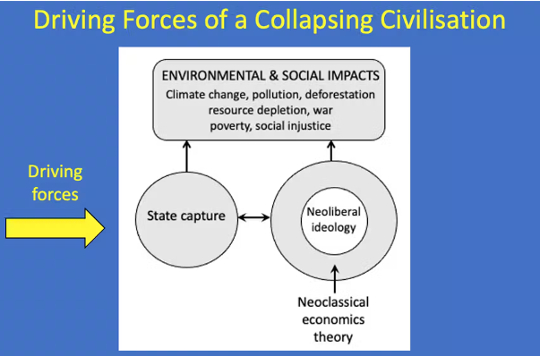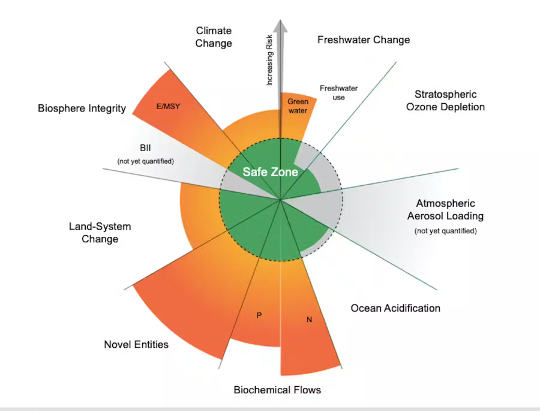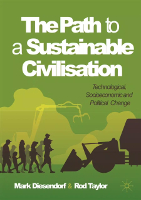Collectively we are driving Earth and civilisation towards collapse. Human activities have exceeded planetary boundaries. We are changing the climate, losing biodiversity, degrading land, contaminating freshwater, and damaging the nitrogen and phosphorus cycles upon which we all depend.
We ask how this could happen. Also, why democratically elected governments ignore the wishes of the majority of their people. Why some governments continue to export fossil fuels despite commitments to climate mitigation. Why some go to war in distant lands without any debate in parliament or congress. Why some give tax cuts to the rich while those on the dole struggle below the poverty line.
The answers to these questions all come down to one thing: decision-makers and influencers are captured by vested interests. That is the inconvenient truth revealed in our new book, The Path to a Sustainable Civilisation: Technological, Socioeconomic and Political Change. But these forces can be overthrown.
We argue it is not sufficient for citizen organisations and governments to address specific environmental, social justice and peace issues. It’s certainly necessary, but we must also struggle for systemic change. This means challenging the covert driving forces of environmental destruction, social injustice and war, namely, “state capture” and the dominant economic system.
It’s 90 seconds to midnight on the Doomsday Clock, so there’s no time to waste.
Confronting state capture
Political scientists and political economists argue governments, public servants, the media and indeed the majority of decision-makers and influencers become captured by vested interests.
This is known as state capture, where state means the nation-state. The captors include fossil fuel, armaments, finance, property and gambling industries.
State capture can also involve foreign governments. There is justifiable concern in Australia and elsewhere about subversion by the Chinese Communist Party.
Yet there is little discussion of the fact that, since 2015, six “retired” US admirals worked for the Australian government before the AUKUS announcement on nuclear powered submarines.

The forces driving the collapse of civilisation, in a nutshell. Mark Diesendorf, Author provided
State capture could explain why Australia’s defence is being shifted to the South China Sea under US sovereignty.
Confronting state capture involves reversing several undemocratic practices. Of particular concern is the funding of political parties by corporate interests as well as the revolving-door jobs between government and corporate interests.
There is also the concentration of media ownership and the influence of so-called “think tanks” funded by vested interests.
The first step is to set up coalitions or networks to oppose the power of vested interests. This would bring together diverse civil society organisations with common interests in democratic integrity and civil liberties.
One example is the Australian Democracy Network, which campaigns for “changes that make our democracy more fair, open, participatory, and accountable”. The Network was founded in 2020 by the Human Rights Law Centre, the Australian Conservation Foundation and the Australian Council of Social Service.
Challenging economic ideology
Conventional economic theory failed us when it came to recovery from the Global Financial Crisis of 2007–09 and the COVID pandemic. Nevertheless, many governments still accept its prescriptions.
The dangerous and destructive myths of conventional economics include the claims that:
- economic theory can treat the natural environment as an infinite resource and infinite waste dump
- endless economic growth on a finite planet is feasible and desirable
- wealth trickles down from the rich to the poor
- wellbeing and welfare can be measured by GDP
- government intervention in the market must be avoided.
Although these myths have been refuted many times, even by world famous economist Joseph Stiglitz, they still determine much government policy.
Australian economist Steve Keen first published Debunking economics in 2001. The financial crisis of 2007 gave him plenty of material for a revised edition in 2011. Richard Denniss gave us Econobabble: How to Decode Political Spin and Economic Nonsense in 2021. Yet, as John Quiggin so eloquently puts it, dead ideas still stalk the land (Zombie Economics.
They have devastating impacts on our life support system (the biosphere) and social justice. One of the principal destroyers of our planet is excessive consumption, especially consumption by rich individuals and rich countries.
A more appropriate economic framework for human and planetary wellbeing is the interdisciplinary field of ecological economics.
Unlike neoclassical economics, ecological economics gives priority to ecological sustainability and social justice over economic efficiency. It works towards a transition to a steady-state economy. That is, one with no global increase in the use of energy, materials and land, and no increase in population.

Human activity is crossing planetary boundaries. E/MSY is Extinctions/Mammal Species Years; the biogeochemical flows beyond the safe operating limits are nitrogen (N) and phosphorus (P). Some sectors are not yet quantified. Azote for Stockholm Resilience Centre/Stockholm University, Author provided
Since planetary boundaries have already been exceeded and low-income countries must develop, social justice demands that the rich countries undergo planned degrowth.
On the pathway to a sustainable civilisation, environmental protection and social justice must be addressed together. Because the rich are responsible for the biggest environmental impacts, reducing the gap between rich and poor is critical.
Universal basic services such as improved public health, education, housing and transportation – and a government-funded job guarantee – can achieve greater equality and give people incentives to support the transition.
Citizen action
Why would governments free themselves from state capture and discard economics ideology? Former US President Franklin D. Roosevelt once told a delegation: “OK, you have convinced me. Now get out there and make me do it!” In other words, pressure from voters is needed to make government action politically feasible.
That’s why we need citizen-based environmental, social justice, public health and peace groups to form alliances to challenge the overarching issues of state capture and flawed economics ideology.
![]()
Book by this Author
The Path to a Sustainable Civilisation: Technological, Socioeconomic and Political Change
by Mark Diesendorf and Rod Taylor The Path to a Sustainable Civilisation shows that we have unwittingly fallen into an existential crisis of our own making. We have allowed large corporations, the military and other vested interests to capture governments and influence public opinion excessively. We have created a god called ‘the market’ and allowed our most important decisions to be made by this imaginary entity, which is in fact a human system controlled by vested interests. The result has been the exploitation of our life support system, our planet, and most of its inhabitants, to the point of collapse.
The Path to a Sustainable Civilisation shows that we have unwittingly fallen into an existential crisis of our own making. We have allowed large corporations, the military and other vested interests to capture governments and influence public opinion excessively. We have created a god called ‘the market’ and allowed our most important decisions to be made by this imaginary entity, which is in fact a human system controlled by vested interests. The result has been the exploitation of our life support system, our planet, and most of its inhabitants, to the point of collapse.
This book argues that the way out of our black hole is to build social movements to apply overwhelming pressure on government and big business, weaken the power of vested interests and strengthen democratic decision-making. This must be done simultaneously with action on the specific issues of climate, energy, natural resources and social justice, in order to transition to a truly sustainable civilisation.
For more info or to order this book, click here.
About The Author
Mark Diesendorf, Honorary Associate Professor, UNSW Sydney
This article is republished from The Conversation under a Creative Commons license. Read the original article.
Books on The Environment from Amazon's Best Sellers list
"Silent Spring"
by Rachel Carson
This classic book is a landmark in the history of environmentalism, drawing attention to the harmful effects of pesticides and their impact on the natural world. Carson's work helped to inspire the modern environmental movement and remains relevant today, as we continue to grapple with the challenges of environmental health.
Click for more info or to order
"The Uninhabitable Earth: Life After Warming"
by David Wallace-Wells
In this book, David Wallace-Wells offers a stark warning about the devastating effects of climate change and the urgent need to address this global crisis. The book draws on scientific research and real-world examples to provide a sobering look at the future we face if we fail to take action.
Click for more info or to order
"The Hidden Life of Trees: What They Feel, How They Communicate?Discoveries from A Secret World"
by Peter Wohlleben
In this book, Peter Wohlleben explores the fascinating world of trees and their role in the ecosystem. The book draws on scientific research and Wohlleben's own experiences as a forester to offer insights into the complex ways that trees interact with one another and the natural world.
Click for more info or to order
"Our House Is on Fire: Scenes of a Family and a Planet in Crisis"
by Greta Thunberg, Svante Thunberg, and Malena Ernman
In this book, climate activist Greta Thunberg and her family offer a personal account of their journey to raise awareness about the urgent need to address climate change. The book provides a powerful and moving account of the challenges we face and the need for action.
Click for more info or to order
"The Sixth Extinction: An Unnatural History"
by Elizabeth Kolbert
In this book, Elizabeth Kolbert explores the ongoing mass extinction of species caused by human activity, drawing on scientific research and real-world examples to provide a sobering look at the impact of human activity on the natural world. The book offers a compelling call to action to protect the diversity of life on Earth.


















